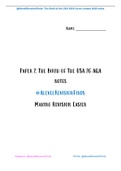Summary
Summary The Birth of the USA AQA notes (AS/A-Level) for Topic 2G *NEW 2021*
- Module
- Birth of the USA topic 2G
- Institution
- AQA
THESE NOTES COVER YEAR 12 AND YEAR 13 CONTENT (AS AND ALEVEL) These notes were written from an A* History A-level student. I was able to make concise notes that contain information on the important aspects of the USA course to boost my own understanding, as well as adding some extra information ...
[Show more]



